YAMAGATA
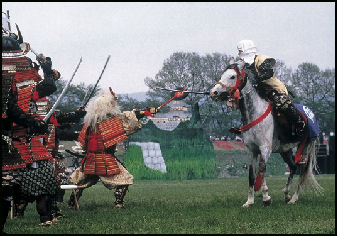
batle re-enactment in Yamagata Yamagata (north of Aizu-Wakamatsu, west of Sendai) is an industrial town with 250,000 people. There isn't much to see. It is a useful jumping off point for trips to Dewa Sanzan, Mt. Yao and Yamadera Temple. Yamagata Prefecture boasts the highest snowfalls in Japan. On the Japan Sea side of the mountains around Yamagata city snow depths sometimes reach 18 feet. Skiing is often possible well into April and snow can be seen as late as July.
300 kilometers north of Tokyo,
Yamagata Prefecture covers 9,323.15 square kilometers (3,600 square miles), is home to about 1.12 million people and has a population density of 120 people per square kilometer. Yamagata city is the capital and largest city, with about 254,000 people. It is in Tohoku, the northernmost region of Japan's Honshu island. It is the land that haiku poet Matsuo Basho described in his book Narrow Road to the Deep North (1689). [Source: Steve John Powell and Angeles Marin Cabello, BBC, May 13, 2021]
Yamagata the home of three sacred mountains: the Dewa Sanzan, which attracts yamabushi, white-robed ascetics that follow the ancient Japanese mountain religion called Shugendo. It is possible to participated in a yamabushi training program to connect with nature and strengthen and relax your mind and body. Various programs offer different activities: stay at the Daishobo pilgrim lodge where you can try vegetarian cuisine, hike sacred trails and even try your hand at waterfall meditation. Yamabushido Team. Toge, Haguro-machi, Tsuruoka-shi, Yamagata yamabushido.jp
Much of Tohoku is isolated, mountainous and prone to some of Japan's heaviest snowfalls.Snow trekking and snow trips are offered in the winter in the mountains through beech and larch forests. The snow is often so deep that hikers with snowshoes sink knee deep in snow that reaches the tree tops. Tracks of hares, foxes and sometimes monkeys are seen but you have to be lucky to see the animals themselves. Mt. Haguro in Yamagata Prefecture was given a three-star rating in the 2009 Michelin Guide on the basis of it cedar-lined road and links to Shugendo mountain asceticism.
Websites: Welcome to Yamagata Yamagata Prefecture Tourism Budget Accommodation: Japan Youth Hostels Japan Youth Hostels Check Lonely Planet books Getting There: Yamagata is accessible by air and by bus and by shinkansen train from Tokyo (two and half hours) and Osaka (Six and a half hours) and other Japanese cities. Lonely Planet Lonely Planet
Places in Yamagata
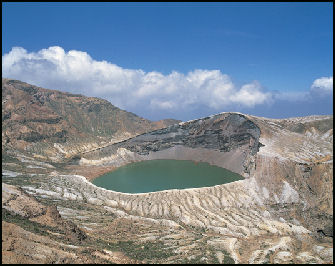
Mt. Zao in the summer Yonezawa (southeastern part of Yamagata prefecture) is a small castle town with 100,000 people that is spread out over 54.9 square kilometers. The Azume and Iide mountains surround the city. These mountains have beautiful Alpine scenery, 10 hot springs and five ski resorts. During the winter people go on snowshoeing tours here.
Yamadera (15 minutes by train from Yamagata station) means mountain temple. Visitors here hike to the 40 temples on a hillside, the highest of which is reached by a climb up 1,100 steps. The temples are built among the steep rock faces, which were regarded as a kind of interface between the real world and spirit world. The first temple, was founded in 860. It contains the “flame of belief” which is said to have burned continuously for more than 1,000 years. On the trail leading uphill from this temple is a “good luck tree” filled with ¥1 coins. Further up is the Godaido pavilion, a wooden viewing platform with a great view of the valley below. Websites: Yamagata Prefectural government site Yamagata Kanko Wikitravel Wikitravel
Dewa Sanzan and Yamabushi
Dewa Sanzan (north of Yamagata city) is a cluster of three sacred peaks — Mt. Haguro-san, Mt. Gas-san and Mt. Yudono-san — that for centuries have been pilgrimage destinations of yamabushi (mountain priests). It is possible to hike one or two of the mountains in a day. Many people stay at the 30 shukubo (temple accommodation) in the town of Toge. Websites: Yamagata Prefectural government site Yamagata Kanko ; Wikitravel Wikitravel ; Map: yudonosan-stay.com Getting There: Lonely Planet Lonely Planet
For the Yamabushi, each of the three mountains embodies a different deity and a different step on the road to rebirth. Mount Haguro represents the present, and people pray here for worldly happiness. Mount Gassan, the Mountain of the Moon, is the past, where the spirits of the ancestors rest. Here, people pray for a peaceful afterlife. Mount Yudono is the future, and the place of rebirth.
Some of trails used to be reserved for yamabushi. Now anyone, regardless of age or fitness, can experience do them and experience the therapeutic effects of Dewa Sanzan's Journey of Rebirth. As the Yamabushi say: "Back to Nature, back to yourself."
History of the Dewa Sanzan Yamabushi
For more than 1,400 years, Yamabushi monks have been walking the sacred mountains of Dewa Sanzan (literally, "the Three Mountains of Dewa Province"). Steve John Powell and Angeles Marin Cabello of the BBC wrote: The sacred status of the three mountains — Mount Haguro, Mount Gassan and Mount Yudono — dates to A.D. 593 when Prince Hachiko fled Japan's then-capital Kyoto following the assassination of his father, Emperor Sushun. Prince Shotoku, the Emperor’s nephew, advised Hachiko to flee to Mount Haguro, where it was said he would encounter Kannon, the Goddess of Mercy. [Source: Steve John Powell and Angeles Marin Cabello, BBC, May 13, 2021]
Prince Hachiko built shrines on each of the three peaks so that the mountain gods would remain there, thereby ensuring peace and prosperity for the region. He established the mountains as a centre for Shugendo, a unique Japanese form of mountain worship that dates back to a time when mountains were considered to be deities. As it evolved, Shugendo incorporated elements of Shinto, Buddhism and Taoism.
Dewa Sanzan became a popular place of pilgrimage. According to Kazuhiro, "after Prince Hachiko helped bring an end to a plague that was decimating the local farming community". After 100 days in seclusion praying for an end to the plague, the prince had a vision instructing him to make a huge fire. He shared his vision with the people, who then built a large effigy of a demon and burned it.
During the Edo Era (1603-1868), pilgrimages to Dewa Sanzan gained popularity as a means of recovering one's youthful vigour. Samurai warriors were among those who came to train here, and the climb became known as the Journey of Rebirth. Prince Hachiko's name is still invoked in times of crisis. In May 2020, a special fire festival was held at Dewa Sanzan shrine to pray for an end to the Covid-19 pandemic. "We hope to borrow the power of our founder Prince Hachiko and support the exhausted feelings of the people during the coronavirus pandemic," a priest told the local Shonai Nippo newspaper.
See Yamabushi Rituals Under YAMABUSHI, SHUGENDO AND MOUNTAIN ASCETICISM IN JAPAN factsanddetails.com
Yamabushi Training Course
Steve John Powell and Angeles Marin Cabello of the BBC wrote: Meanwhile, a growing number of people from around Japan and abroad are discovering the continuing relevance of Dewa Sanzan's healing energy. Yamabushi training has changed little in the last 1,400 years. The difference is that now you too can join them. After some 30 years running courses in Japanese only, interest from abroad convinced Master Hoshino to start offering his courses in English too. "I live by the Yamabushi tradition and I teach others to do the same," said Master Hoshino. [Source: Steve John Powell and Angeles Marin Cabello, BBC, May 13, 2021]
Several thousand people took the training course in 2019. "The course has been particularly popular with high-achiever Steve Jobs-types, overworked executives seeking to reconnect with themselves through a deep connection with nature," said Hiroyuki Yoshizumi, a Yamabushi at Haguro Tourist Office, who arranges Yamabushi experiences for visitors. "Many return to take the course three or four times."
There are various options, including one-day, two-day and four-day courses, with accommodation usually in Shukubo, or pilgrim's lodges, dotted around Mount Haguro. Participants must walk in silence for the entire duration. Also, no phones, no watches, no brushing teeth, shaving, reading or writing are permitted.Meditation under a waterfall is among the rituals required to become a certified Yamabushi
Only one word is permitted to be spoken during the entire course. "When the Master Yamabushi gives you an instruction, you have to respond by saying 'uketamou' (I accept)," explained Tokyo-based PR consultant Yumiko Nishitani, after completing the one-day Mount Haguro hike. "Through this routine," she added, "you learn to accept everything as it is. This way, participants are forced to live in the moment. So, Yamabushi training is for not only for enlightenment and self-discovery but also for mindfulness." Challenging as this sounds, it helps you transcend your habitual ways of thinking and acting, and focus on the present moment rather than fretting about the future. [Source: Steve John Powell and Angeles Marin Cabello, BBC, May 13, 2021]
We want people to face themselves, to look at the feet they are standing on, and to feel a connection with nature, society, and the world," said Maiko Ito, a Yamabushido Project Leader. "Once you know yourself, you start to think about what you want to do, and what you should do and how you can best participate in society."
Dewa Sanzan Yamabushi Trek
On a hike in Dewa Sanzan, Steve John Powell and Angeles Marin Cabello of the BBC wrote: The trek begins at the great red torii or gateway at the foot of the mountain. Like all torii, it marks the entrance to sacred ground where deities dwell. Just 414 meters (1,358 feet) tall, Haguro is the only peak to remain open all year, while the other two taller montains spend winter snowbound.
Haguro is home to a splendid five-storey wooden pagoda that rises 30 meters (98 feet) high amid the trees like a natural part of the forest. A few meters away looms the equally marvellous Jiji-sugi or Grandpa Cedar. Believed to be more than 1,000 years old, this Designated Natural Monument wears a shimenawa rope around its trunk, indicating the tree's sacred status (in both Shinto and Shugendo, trees, rocks, rivers and other natural phenomenon are believed to be inhabited by deities).
Yamabushi training is for not only for enlightenment and self-discovery but also for mindfulness From here, a spectacular stairway of 2,446 stone steps (about 1.7 kilometer, 1.1 miles) leads to the summit. The path, dating from 1648, is lined with 580 cedar trees, some more than 600 years old. Immersed in utter silence among these magnificent trees, the niggling worries and noisy chatter that usually clutter your mind are replaced by a serene well-being, like when you meditate. As Master Yoshino said, "we leave ourselves in Nature, we make space in our minds."
Finally, you arrive at the Sanjin Gosaiden shrine where the deities of all three mountains are enshrined, making it a major place of worship. Its thatched roof is more than 2 meters thick — the largest in Japan.
Mount Gassan, the second peak, is the highest and most imposing of the three mountains, standing at 1,984 meters (6509 feet). A long ridge connects Gassan to the other two peaks, offering superb vistas of the surrounding countryside. Gassan's open pastures and fresh breezes contrast with the deep forests of Haguro. Your heart smiles at the sight of myriad alpine flowers around the wetlands of Midagahama Moor. As Gassan is the abode of the spirits of the ancestors, you are symbolically passing through the Land of the Dead on your way to rebirth.
The climax of the hike is Mount Yudono, the 1,504-meter (4,934-foot) mountain of the future, and holiest of the three peaks. Half way up is a copper-coloured boulder where hot spring waters gush out. This spot is so sacred that no photos are permitted. It is forbidden to even speak in detail of what you have seen at the shrine, said to be the point of rebirth. As Basho wrote:
I cannot speak of Yudono
But see how wet
My sleeve is with tears
What I can tell you is that Mount Yudono is also home to a spectacular dual waterfall that thunders into a rock pool below. Here participants are instructed to stand under the icy cascade while reciting a sutra for a teeth-chattering minute. With a hearty "Uketamo!" you stride into the pool. Unsurprisingly, this part of the programme is discontinued once summer passes, when it becomes too cold for all but the hardiest of ascetics.
But if cold showers and strenuous hiking are not for you, there are other less-demanding options, like the one-day Mount Haguro-only hike. As Kazuhiro explained, "That way, you still get to visit Dewa Sanzan shrine. The deities of all three mountains are enshrined there, so it's the same as visiting all three peaks."
Mt. Zao
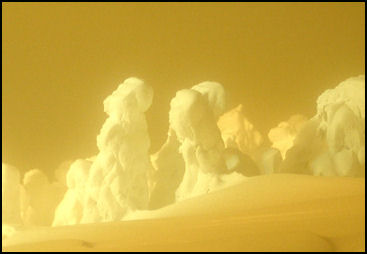
Mt. Zao monsters Mt. Zao(southeast of Yamagata) contains several lofty volcanic peaks and many good hot springs. Popular with mountain climbers in the summer and skiers in the winter, the mountain is known for an unusual meteorological phenomena that occurs in the winter and covers entire trees with unusual silver ice crystals.The hoar-frosted, pure white trees are called “juhyo” ("snow monsters”).
In the summer many hikers head to the beautiful Okayama crater lake that was created by an eruption 400 years ago. Located in a bowl with a lip that rises above the crater, it is said to change colors five times a day but is usually jade green.
The popular ski resort of Appi and traditional Yamagata Zao Onsen provide access to the juhyos and crater lake. Zao Onsen (45 minutes by bus from Yamagata) is a Swiss-Alps-style village with a wonderful onsen. To reach the crater lake you can take hiking trails or a cable car ride.
Websites: Yamagata Prefectural government site Yamagata Kanko Samurai Dave blog Samurai Dave ; Mt. Zao Map: skiresort.info/ski-resort/zao-onsen/trail-map ; Hiking and Getting There: Japan Hike Japan Hike
Aizu-Wakamatsu
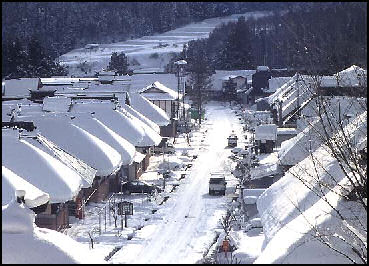
Aizu-Wakamatsu (175 miles north of Tokyo) is an old castle town with many old merchant houses and attractive old storehouses as well as few well preserved samurai houses. Tsuruga Castle dominates the center of the city. From the top of the 36.5-meter-high keep are wonderful views of the town. The castle itself as built in the 1960s. It is a concrete reconstruction of wooden castle that once stood here.
Aizu-Wakamatsu is a convenient starting point for excursions into the Bandai-Azuma Mountains. This You can sample local sakes by doing a brewery hop. Many of the town’s 13 sake breweries are located near one another in the downtown area. Aizu-Wakamatsu is also known for its kites, ginseng, lacquerware, and candles with hand-drawn flowers.
Websites: Aizu-Wakamatsu city site samurai-city.jp JNTO article JNTO Map: Wiki Open Street wiki.openstreetmap.org ; Ryokan and Minshuku Japanese Guest Houses Japanese Guest Houses Budget Accommodation: Japan Youth Hostels Japan Youth Hostels Check Lonely Planet books Getting There: Aizu-Wakamatsu is accessible by air and by bus and by train from Tokyo (two and half hours) and Osaka (six hours) and other Japanese cities. From Tokyo you take the shinkansen north to Koriyama and change to JR local trains. Lonely Planet Lonely Planet
Bandai Plateau Area

mud volcano at Goshogake onsen Bandai Plateau (near Aizu-Wakamatsu) of Bandai-Asahi National Park is the second largest plateau in Japan after Daisetsuzan in Hokkaido. It is dotted with more than 200 lakes created by the eruption of Mt. Bandai, a volcano that still emits sulfur-smelling smoke. There are many well equipped camping areas and hiking trails.
Mt. Bandai last erupted in 1988. When it erupted catastrophically thousands of years ago it blasted peaks away peaks, filling in canyons and creating the Bandai Plateau. During the winter hikers with snowshoes head to the crater of Mt. Bandai to see the unusual yellow-orange frozen waterfall created from frozen iron- and sulfur-rich water that looks more like melted wax than frozen water.
Websites: Government National Park Site National Parks of Japan Map: env.go.jp/park/bandai ; Getting There: There are buses to the trail heads from Aizu-Wakamatsu. Lonely Planet Lonely Planet
Lake Inawashiro (near Aizu-Wakamatsu) is the third largest lake in Japan. Located on the south of the Badai Plateau. It is a good summer resort with several fine beaches and several areas which rent boats and sponsor sightseeing boat trips. Websites: JNTO article JNTO ;
Fukushima

"mud volcano" at Goshogake onsen Fukushima Prefecture covers 13,783.74 square kilometers (5,322 square miles), is home to about 1.9 million people and has a population density of 139 people per square kilometer. Fukushima is the capital and largest city, with about 295,000 people. It is in Tohoku on northern Honshu island and has 13 districts and 59 municipalities. Tourist usually give the prefecture a wide berth due to its association with Fukushima nuclear power plant disaster after the 2011 earthquake and tsunami.
Ouchijuku is an Edo-era post town, established around 1640. It was once a stop on the road from Nikko to Aizu but it is now a major destination in its own right. The picture postcard idyllic row of thatched houses is even more photogenic in the winter, blanketed by snow. Step inside Misawa-ya to warm up by the irori (‘sunken fire pit’) hearth, and don’t leave without sampling negi-soba – with a leek in place of chopsticks! Location: Yamamoto, Ouchi, Shimogo-machi, Minamiaizu-gun, Fukushima; website ouchi-juku.com
Licca-chan Castle (in Ono, Fukushima Prefecture) is where all the body parts of the Barbie-like Licca-chan doll are made and assembled. Its museum displays a collection of all the past Licca-chan dolls and sells original merchandise. [Source: Akihito Teramura, Yomiuri Shimbun, November 23, 2012]
Tamura (Fukushima Prefecture) is a small town a few miles inland from the Pacific that several interesting sights, including Isozaki shrine, built into a cliff face; Hoshinomura Tenmodnai, one of Japan’s largest astronomical observatories; and several caves with spectacular stalactites and stalagmites reached by a network of stairways illuminated with colored lights. Takine Goten, a cave with a spectacular 400 square meter chamber with a slanted waterfall, is particularly awesome. Tourism Office: (0247)-81-2136, website: city.tamura
Hajimari Art Center is located in a renovated 19th century sake brewery. This Yoshiji Takehara-designed building is a unique art brut art center which opened in 2014 to foster a better understanding of the works of artists not commonly placed within the traditional and institutional trajectories of the fine arts. It is also one of the very few art centers around the world operated by a support facility for individuals with disabilities. Location: 4873 Ara-machi, Inawashiro-machi, Yama-gun, Fukushima 969-3122 Tel: +81-242-62-3454 Fukushima | Inawashiro Art center 19 Butterfly Stool by Sori Yanagi
Ebisu Circuit in Fukushima: Learn Tokyo Drifting
Ebisu Circuit (two hours from Tokyo, in Fukushima) is a place where you experience authentic drifting like that featured in the 2006 film “The Fast and the Furious: Tokyo Drift”. Ebisu is one of Japan’s most popular circuits. It is a must for motorsport fans: the chance to ride with professional drivers.
The sport of drifting originated in Japan. Drifting is a driving technique where the driver intentionally oversteers, with loss of traction, while maintaining control and driving the car through the entirety of a corner. Famous motorcyclist turned driver Kunimitsu Takahashi was the foremost creator of drifting techniques in the 1970s. He won several championships and a legion of fans who enjoyed the spectacle of smoking tires. The bias-ply racing tires of the 1960s–1980s lent themselves to driving styles with a high slip angle. Keiichi Tsuchiya, known as the "Drift King", became particularly interested by Takahashi's drift techniques. Tsuchiya began practicing his drifting skills on the mountain roads of Japan, and quickly gained a reputation amongst the racing crowd. In 1987, several popular car magazines and tuning garages agreed to produce a video of Tsuchiya's drifting skills. The video, known as Pluspy, became a hit and inspired many of the professional drifting drivers on the circuits today. In 1988, alongside Option magazine founder and chief editor Daijiro Inada, he helped to organize one of the first events specifically for drifting called the D1 Grand Prix. [Source: Wikipedia]
At Ebisu Circuit in Fukushima strap yourself into the bucket seat of a Toyota drift taxi (up to three passengers per car) and actual D1 drivers from the renowned Team Orange — true pioneers of the sport — will take you on a thrilling spin around the circuit, showcasing their incredible technique to the max. With a range of courses on offer, you’ll be able to experience Ebisu Circuit from all angles. Location: 1 Sawamatsukura, Nihommatsu-shi, Fukushima; Website: Ebisu Circuitgovoyagin.com
Fukushima Daiichi Nuclear Power Station
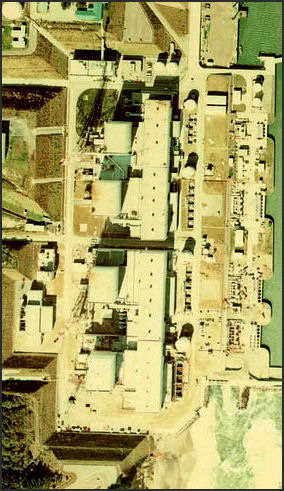
Fukushima Plant in 1975 Fukushima No.1 (Daiichi) Nuclear Power Station is 170 miles north of Tokyo. Designed by General Electric, with a design similar to that of the Oyster plant in near Toms River, New Jersey, it went into operation in 1971 and was supposed to have been retired after 30 years of operation but, only a month before the disaster, had been approved by the Japanese government to keep operating for another ten years despite warnings about its safety. The plant’s life span was approved despite safety warnings and flaws such as radiation damage to pressure vessels that hold the fuel rods; corrosion on spray heads used to douse the suppression chamber; corrosion on key bolts in the reactors; and problems with gauges that monitor water flow into the reactor.
The Fukushima No. 1 nuclear power plant is owned and operated by Tokyo Electric and Power Company (TEPCO), which supplies a third of Japan’s power. People who lived around the plant had been grateful that it provided jobs and subsidized kindergartens, parks and community centers. Reactors No. 1 and 2 were made by GE. Reactor No.3 was made by Toshiba. Reactor No.4 was made by Hitachi.
Evan Osnos wrote in The New Yorker: Fukushima, which means “fortunate island,” erected its first plant — the one struck by the tsunami — on the former site of a Second World War imperial air base. Then it built another, not far down the rocky coast. Locals referred to their new skyline as the Nuclear Ginza, after the posh neighborhood in Tokyo. In a town beside the Fukushima Daiichi plant, people erected a sign that declares “Nuclear Power Is the Energy of a Bright Tomorrow.” The plant, about a hundred and fifty miles north of Tokyo, is painted white and pale blue and is a labyrinth of boxy buildings and piping on a campus larger than the Pentagon’s. It has six reactors. [Source: Evan Osnos, The New Yorker, October 17, 2011]
One of the main faults with the outdated reactors at Fukushima nuclear power plant is that they have small suppression chambers, which increases the risk of a pressure build up in the reactor (newer reactors have larger suppression chambers). One of the main reasons the life span of Japan’s aging nuclear power plants is being extended is that is strong opposition to new plants and very high costs involved with building new plants and shutting down old ones.
The Fukushima No.1 Nuclear Power Station has six nuclear reactors. There is also Fukushima Nuclear No. 2 Power Station nearby four reactors,. At the time of the disaster reactors No. 1, No. 2 and No. 3 of the Fukushima No.1 plant were operating. Reactors No. 4, No. 5 and No. 6 were not operating due to periodic inspection. Like most nuclear power plants the reactors — that contained the nuclear fuel rods that generated heat that produced steam that turn turbines to make electricity — has three layers of protection: the containment building; the containment vessel, and the metal cladding around fuel rods, which are inside the reactor.
The reactor pressure vessel that covers the reactor core is designed to prevent radiation from being released should something go wrong with the nuclear fuel. Even if the reactor vessel were damaged, radiation leaks are supposed to be prevented by another container surrounding it. Around these is the reactor's outer building.
Meltdowns at Fukushima Nuclear Power Plant after the 2011 Tsunami

Smoke After Reactor Explosion
After the gigantic earthquake and tsunami struck the Fukushima Daiichi nuclear power plant on March 11, 2011, reactors No. 1, 2 and 3 at the plant suffered core meltdowns Reactor No. 4 avoided a meltdown but a hydrogen explosion blew open the roof and walls of the reactor building. The fragile state of the No. 4 reactor and its spent fuel pool—containing highly radioactive fuel rods, located 130 feet above ground level — led some experts to warn that a severe aftershock could damage the tank and leave the fuel rods dangerously exposed, releasing huge amounts of radiation.
The New York Times reported: "As Japan struggled with a rescue effort after the earthquake and tsunami it also faced a nuclear emergency with explosions and leaks of radioactive from three reactors at the Fukushima Daiichi Nuclear No.1 Power Station while spent fuel rods at another reactor overheated and caught fire, releasing radioactive material directly into the atmosphere. While no one died in the nuclear accident, the environmental and human costs are huge. [Source: New York Times] Shortly after the 9.0 magnitude earthquake and tsunami struck the northern coast of Japan at 2:56pm on March 11, reports emerged of damage at one of Japan’s nuclear power plants. The plant lost its backup power shortly after 3:30 p.m., when it was hit by massive tsunami. Between March 12 and 15, explosions occurred one after another at the Nos. 1, 3 and 4 reactor buildings at the Fukushima No. 1 nuclear power plant operated by Tokyo Electric Power Co. (TEPCO).
Cooling functions were lost at the reactor buildings due to the failure of all power sources as a result of the earthquake and tsunami. Massive amounts of radioactive substances were dispersed into the atmosphere outside the plant. The reactors lost their cooling systems due to the blackout and a hydrogen explosion occurred in the No. 1 reactor in the afternoon of March 12, destroying most of the reactor building.That day Japanese authorities began evacuating residents nearby the Fukushima nuclear power plant due to the release of radioactive elements into the environment, signs of a possible meltdown at one of the reactors. Two days later the government said cooling systems at a third reactor had failed. The Kyodo news agency reported that the damaged fuel rods at the third reactor had been temporarily exposed, increasing the risk of overheating. Sea water was being channeled into the reactor to cover the rods.
David Jolly and Ken Belson wrote in the New York Times, “At the Fukushima Daiichi Nuclear Power Station, Japanese officials have struggled to contain a dire nuclear crisis in the quake's aftermath, facing partial meltdowns at two crippled reactors, fires at a third and cracks at yet another unit with a power outage that prevents the interior radioactive rods from being cooled. The emergency appeared to be the worst involving a nuclear plant since the Chernobyl disaster 25 years ago. The developments at two separate nuclear plants prompted the evacuation of more than 200,000 people. “The disasters require nationwide mobilization for search, rescue and resettlement,” Jolly and Belson wrote “and a scramble for jury-rigged solutions in uncharted nuclear territory, with crises at multiple reactors posing a daunting array of problems. Japan’s leaders need to draw on skills they are woefully untrained for: improvisation; clear, timely and reassuring public communication; and cooperation with multiple powerful bureaucracies.” [Source: David Jolly and Ken Belson wrote in the New York Times, March 18, 2011
Evan Osnos wrote in The New Yorker, “A row of six aging nuclear reactors at the Fukushima Daiichi nuclear power plant had lost their cooling systems, as well as their “backup backup — protections, in the words of one nuclear expert. The prospect of radiation introduced a threat all its own, as invisible as the tsunami was vivid, and throbbing with history. Initially, the Japanese government downplayed the possibility that the ailing plants could leak any significant radiation, but survivors of the atomic bombings of Hiroshima and Nagasaki — the revered generation known as hibakusha’stepped forward to plead for “more sense of crisis.” [Source: Evan Osnos, The New Yorker, March 28, 2011]
OTHER ARTICLES ABOUT THE CRISIS AT THE FUKUSHIMA NUCLEAR POWER PLANT Factsanddetails.com/Japan ; 2011 EAST JAPAN EARTHQUAKE AND TSUNAMI: DEATH TOLL, GEOLOGY AND THEORIES Factsanddetails.com/Japan ; ACCOUNTS OF THE 2011 EARTHQUAKE Factsanddetails.com/Japan ; DAMAGE FROM 2011 EARTHQUAKE AND TSUNAMI Factsanddetails.com/Japan
Image Sources: 1) May Japanese Guest Houses 2) itako 3) Aomori City site 4) Aomori Museum site 5) Onsen Express 6) 7) Hirosaki City site 8) 9) Akita Prefecture site 10) 11) Sendai City site 12) 13) Wikipedia 14) Japan National Parks site 15) 16) Yamagata Prefecture 17 ) Samurai Dave blog 18) Aizu Wakamatsu city 19) Niigata city site 20) 21) Sado Island site
Text Sources: JNTO (Japan National Tourist Organization), Japan.org, Japan News, Japan Times, Yomiuri Shimbun, Japan Ministry of the Environment, UNESCO, Japan Guide website, Lonely Planet guides, New York Times, Washington Post, Los Angeles Times, National Geographic, The New Yorker, Bloomberg, Reuters, Associated Press, AFP, Compton's Encyclopedia and various books and other publications.
Last Updated in January 2023
